Campagnolo Super Record 12 review
Campag is known for its prestigious past but has the Campag Super Record 12-speed groupset lived up to expectation? Gregor Brown seems to think so
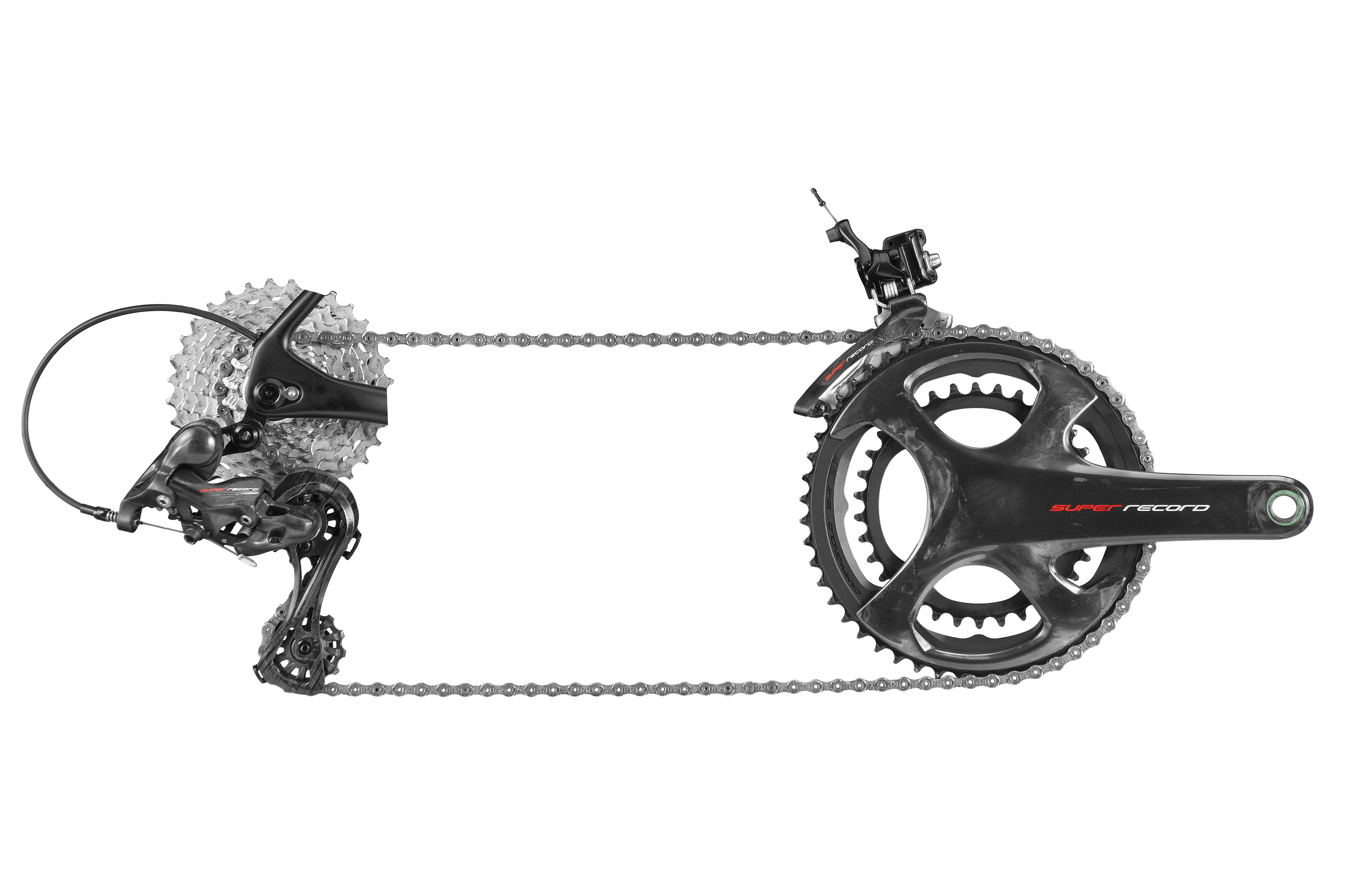
Campagnolo has executed the move to 12 speed with its usual style and flair: the new Super Record components not only look beautiful but they perform beautifully too. Yes, it is expensive, but it’s the world’s most prestigious groupset.
-
+
Ergonomics
- +
-
-
Price
You can trust Cycling Weekly.

Campagnolo became the first of the big three groupset manufacturers to introduce 12-speed to the road market when it unveiled new versions of Record and Super Record last year. The Campagnolo Super Record groupset landed in an innocuous-looking box on Cycling Weekly's doorstep. It came alive when installed and tested.
>>> Road bike groupsets: 2019 hierarchies explained
Whereas the ‘11’ featured as a central part of the design of the previous groupsets, Campagnolo left ‘12’ off any of the components – perhaps to imply that there’s more to the new gruppo than just than another gear.
Both the Record and Super Record groups are new from top to bottom. It is not just the cassette and – radically different looking – rear derailleur, but a major change across all elements. Four new versions are on offer now: both the Record and Super Record offer rim and disc brake versions, with the former coming in direct mount or dual-pivot brake options.
Changes are expected to trickle down to the Chorus, Potenza and Centaur groups soon. The rear derailleur stands out with its longer body, new parallelogram geometry and longer pulley cage of 72.5mm. The jockey wheels have gone up to 12 teeth with more aggressive teeth on the top pulley to move the chain through the cassette more smoothly.
There is also that extra aluminium link which can be removed if you have a direct-mount frame. The shorter connection should offer even better shifting and faster wheel changes with the mech back and clear of the axle. It would be good to try, but for this ride, I'm using a traditional frame and setup. Up front, the changes are not as noticeable but they are certainly there.
The longer front derailleur arm sits separate from the parallelogram plate. Before, it was one piece of forged material, but now it pushes on a tab when shifting. Campagnolo claims this gives a straighter chainline in any gear. The design also reduces the amount of force and lever throw required to make a shift.
The Ergopower levers, as with previous versions, offer multiple index shifting to the front derailleur to find the position that’s exactly right. The right Ergopower shifter allows you to upshift three at a time – ie select lower gears – which is very handy when you race into the base of a climb and need to change quickly – and you can dump five gears in the other direction for the descent via the time-honoured Campagnolo thumb tab. The double curves of the levers remain gentle and sexy, formed from carbon.
Campagnolo Super Record now allows you to set the levers closer to the bars for smaller hands. Also those same small hands will enjoy a redesigned thumb tab that is wider and tilted downwards, easier to reach from the drops. However, it is not as easy to reach as the lowered thumb paddle on the electric groups.
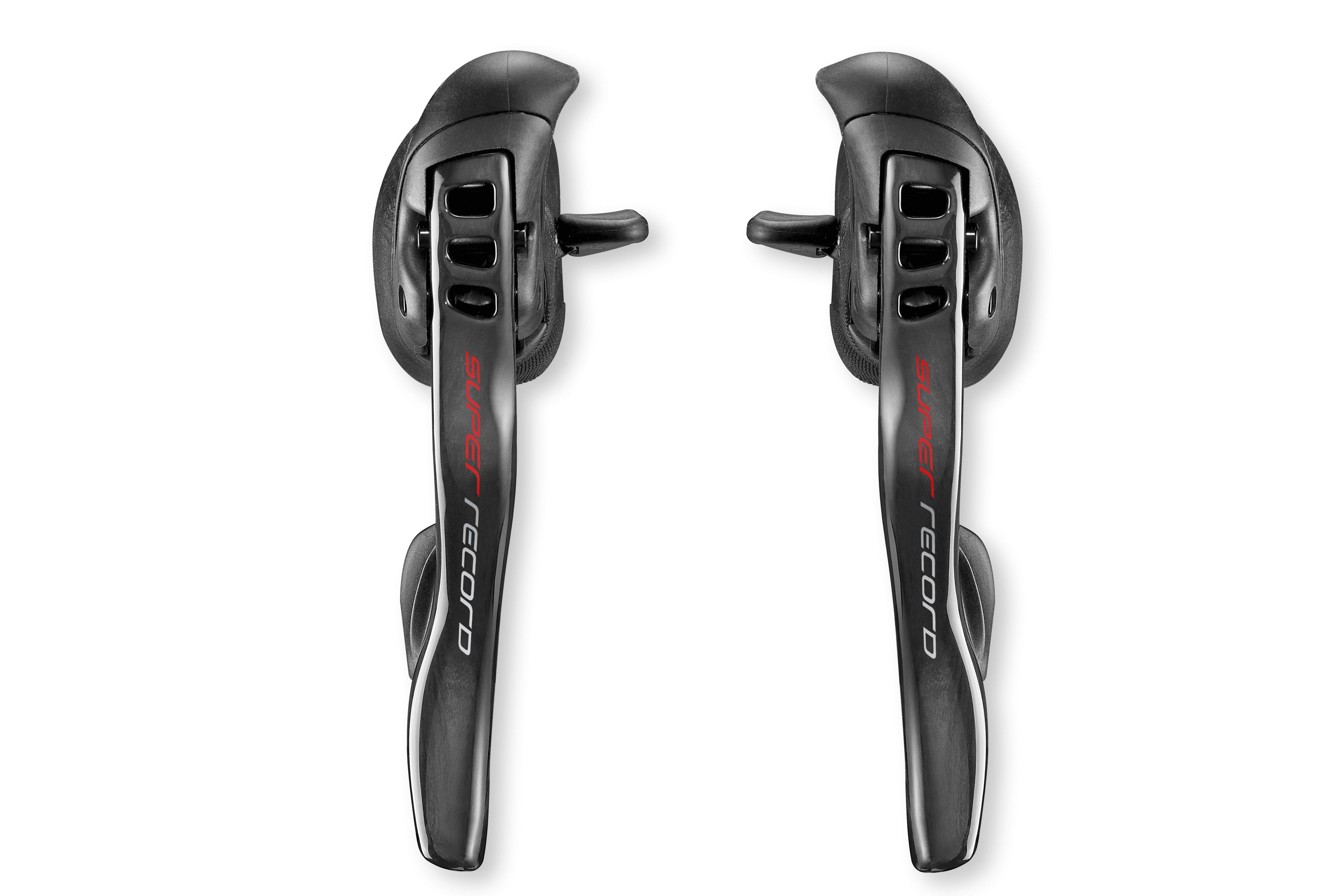
The inner shift blade also is a bit wider and easier to flick with your index finger when needed. The tilt of both Ergo levers also edges further outwards making them even easier to reach and engage. The internals and design, says Campy, reduce much of the free play and are made for more responsive shifting.
If the rear mech looks much more aggressive then the brakes and crankarms take on a sleek and aero look. I like the look of the clean brakeset against the disc setup Campy offers. These calipers, no longer skeleton, look angular and modern. Their function, too, is on a par with Dura-Ace's acclaimed modulation.
The calipers allow for 28c tyres. They also come in direct-mount options. If you are a fan of Campagnolo's crankarm redesign five years ago, you will love the even sleeker new appearance for 2018. The first big change is the lack of a centre hole on the right arm, smoothed over with carbon that runs all the way to the rings, bridging the two opposing pairs of spider arms.
The hollow carbon-fibre arms and extra carbon brace at the outer reaches is said to stiffen up the chainring when sprinting. I could not push it hard enough on the Tuscany roads, but the big professionals will appreciate this.
How does Campagnolo Super Record perform? It took a steady hand and attention to dial in the rear derailleur just right given that the extra 12th gear fits in the same space. Everything is more precise, tighter and better engineered. Consider that now the chain is now only 5.2mm wide. Once it is right, it clicks like a firearm – bang, bang, bang! The chain jumps down one gear, another and another, clicking easily with those redesigned levers. I rode some of my usual routes around Florence, which are never flat for long.
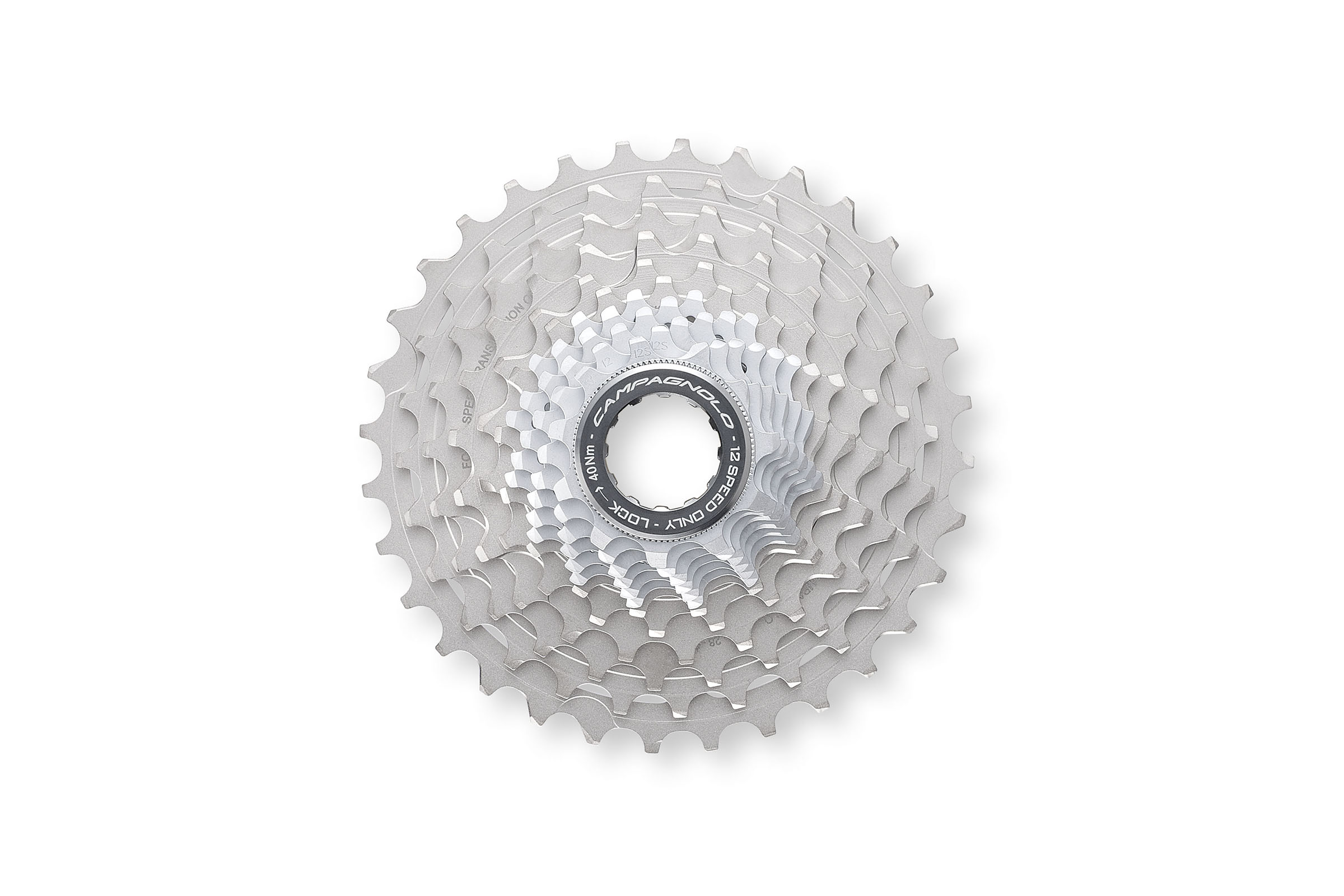
You are constantly climbing or descending. Before, with the 11-speed group, I never felt that I was lacking but now it seems as if the 12th gear is necessary. Clearly it gets one over on its competitors, but Campagnolo made the decision to deal with the widening gap between the smallest and biggest sprocket of rear cassettes.
Even with compact and semi-compact cranksets (I tested the latter), cyclists often reach for 30 or 32-tooth sprockets. Now with the 12 gears, Campy's engineers have filled in the spaces in the cassette so that to include a lower bottom gear doesn’t mean bigger gaps elsewhere. On the climb to Olmo above Florence, with it in the 36 front ring, I easily found the right ratio. Again, I never felt I was lacking before with 11 sprockets, but now every option feels available.
The Campagnolo Super Record cassettes are offered in 11-29 or 11-32, which is the one I tested. The first seven gears on both move up in one-tooth increments. Shifting around to the extremes, I could also feel that Campagnolo improved cross-chainring riding. I put it in the 36x12: no front derailleur rub and smooth rear pulley/cassette movement. Campy says that is down to the front derailleur redesign and the new pulley and 3D Embrace Technology used in the rear mech.
Overall, everything felt precise and without any fuss finding the right ratio or being too crossed in gear selection. Braking felt perfect, too. The levers are easier to grab both from the drops and on top of a more comfortable Ergopower hood. The modulation allowed for feathering heading towards the curves or when the local Tuscan roads descended tightly, an aggressive grab felt just as smooth. Dual-pivot configurations are now used up front and behind for extra stopping power, getting rid of the single-pivot rear caliper that Campagnolo used before.
The ball bearings still are there, allowing that smooth feeling from the caliper's pivots.
Having that 12th sprocket allows you to progress through the gears smoothly but still have an expanded rear block. But the cassette does not just have an extra gear, it is completely different like the groupset. The first six sprockets are individual steel plates as before and the last six gears are divided into two sets of three. Instead of steel or titanium rings with aluminium spiders, now the two sets are each machined from a single piece of steel.
The improved engineering improves durability and keeps the cassette as light as is practically possible, but the new weight of 266g is considerably higher than the 177g of the 11-speed sprockets. The newly designed Ergopower lever makes moving across the block easy, but that is only part of the story. Campagnolo says that the ease is thanks in large to the Maximum Smoothness derailleur cables that reduce friction. The cables look the same on the outside, but the new slippery inners add to the lightness when shifting.
Super Record v Record
The Record and Super Record groups differ in materials, weight and price. The weights: 2,041g compared to 2,213g for Record. Super Record uses Campy's CULT ceramic bearings between the crankset and cups; Record relies on the USB bearings. The cranks use hollow-carbon construction and titanium shafts, where Record uses solid construction arms with a steel shaft connecting the cranks. With those touches, and the extra carbon between the spider arms, the Super Record crankset sees the most significant differences.
Campagnolo Super Record Ergopower levers feature cut-outs and its front derailleur uses an aluminium inner plate and carbon on its outer cage plate. The rear derailleur features more cut-outs and a carbon outer plate. The brake calipers look nearly the same, but Super Record’s feature titanium screws and hardware, as the Super Record groupset does throughout. Super Record definitely shifts and operates smoothly, and has earned the ‘Super’ prefix with its material and design upgrades throughout.
Weight comparison
Campagnolo Super Record 12 v Super Record 11 Campagnolo claims 2,041g for 12-speed Super Record and 2,213g for Record compared to 1,939g for 11-speed Super Record. That’s right, the new groupset is heavier. The biggest weight difference between new and old is in the cassette. The 12-speed cassette, with its thinner sprockets, is heavier, probably because Campagnolo has had to use more steel and less titanium and aluminium.
11-speed Super Record 12-speed Super Record
Rear derailleur 166g-179g (medium) 181g, Ergopower Shifters 342g - 339g (pair), Front derailleur 71g - 79g, Chainset 631g - 618g, Threaded BB cups 45g - 43g, Sprockets 177g - 266g, Chain 210g - 220g Brakes, 297g - 298g.
Complete groupset 1,939g - 2,041g
Prices
Campagnolo Super Record disc brake £2,856.99 Campagnolo Super Record rim brake: £2,614.99 Record disc brake £1,999.99 Record rim brake: £1,764.99

Thank you for reading 20 articles this month* Join now for unlimited access
Enjoy your first month for just £1 / $1 / €1
*Read 5 free articles per month without a subscription

Join now for unlimited access
Try first month for just £1 / $1 / €1
Get The Leadout Newsletter
The latest race content, interviews, features, reviews and expert buying guides, direct to your inbox!
Gregor Brown is an experienced cycling journalist, based in Florence, Italy. He has covered races all over the world for over a decade - following the Giro, Tour de France, and every major race since 2006. His love of cycling began with freestyle and BMX, before the 1998 Tour de France led him to a deep appreciation of the road racing season.
-
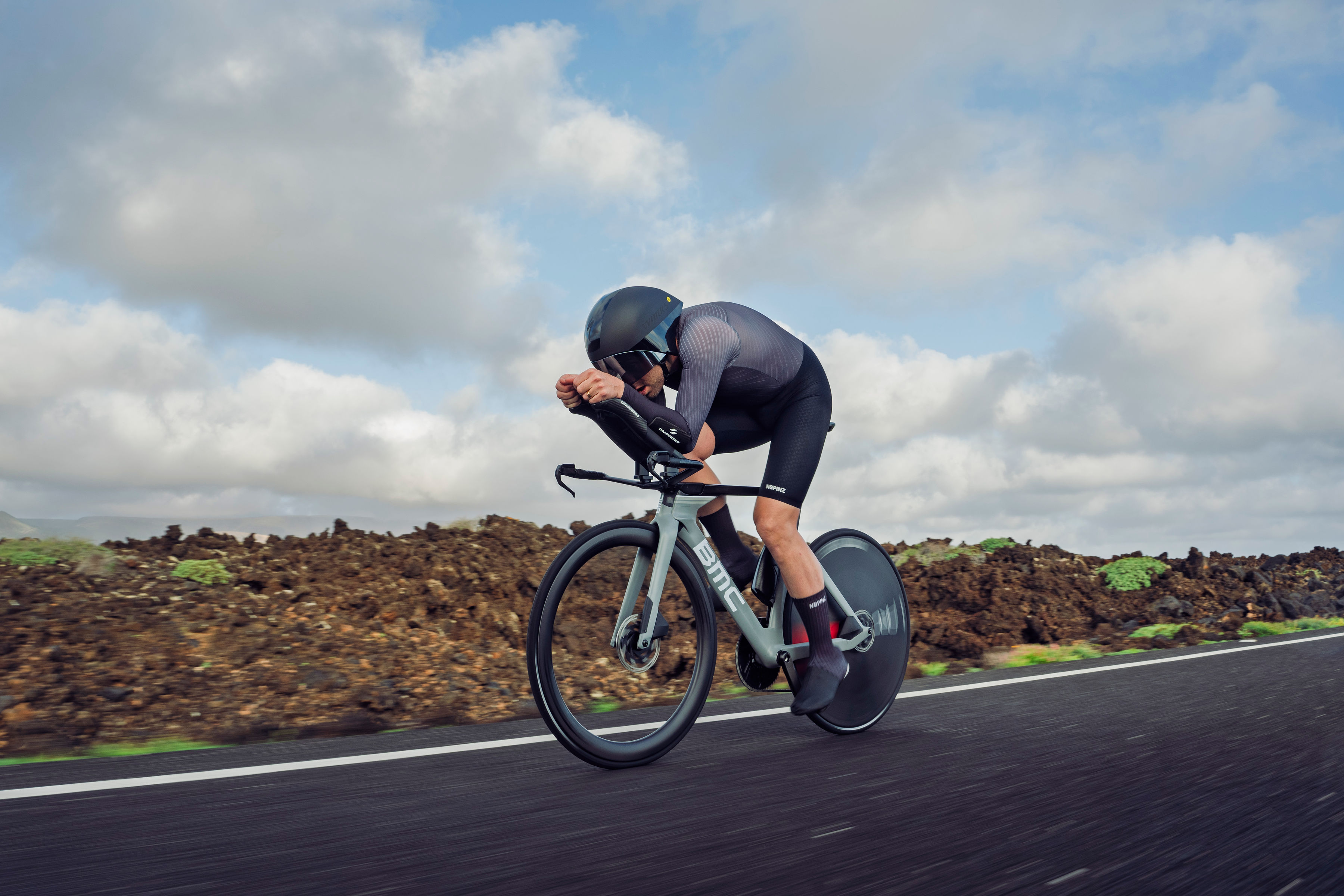 Cycling Time Trials unveils alliance with UK brand Nopinz to 'improve and drive the sport forward'
Cycling Time Trials unveils alliance with UK brand Nopinz to 'improve and drive the sport forward'The UK time trialling body takes on new sponsor with a view to 'driving the sport forward'
By James Shrubsall Published
-
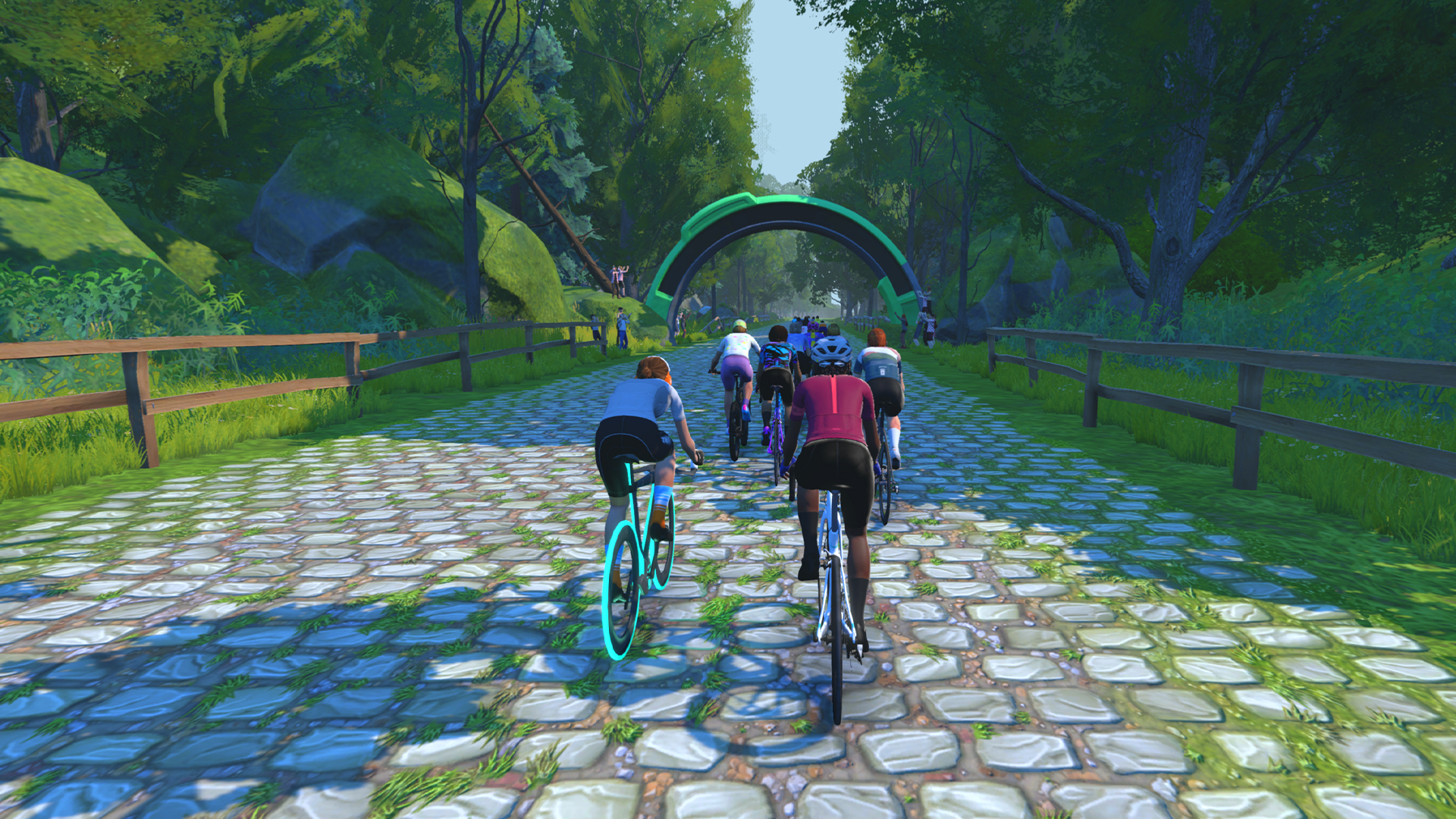 I rode Zwift’s new Paris-Roubaix route - how hellish was it?
I rode Zwift’s new Paris-Roubaix route - how hellish was it?The Hell of the North route has added virtual cobbles to the virtual training and racing platform
By Stephen Shrubsall Published
-
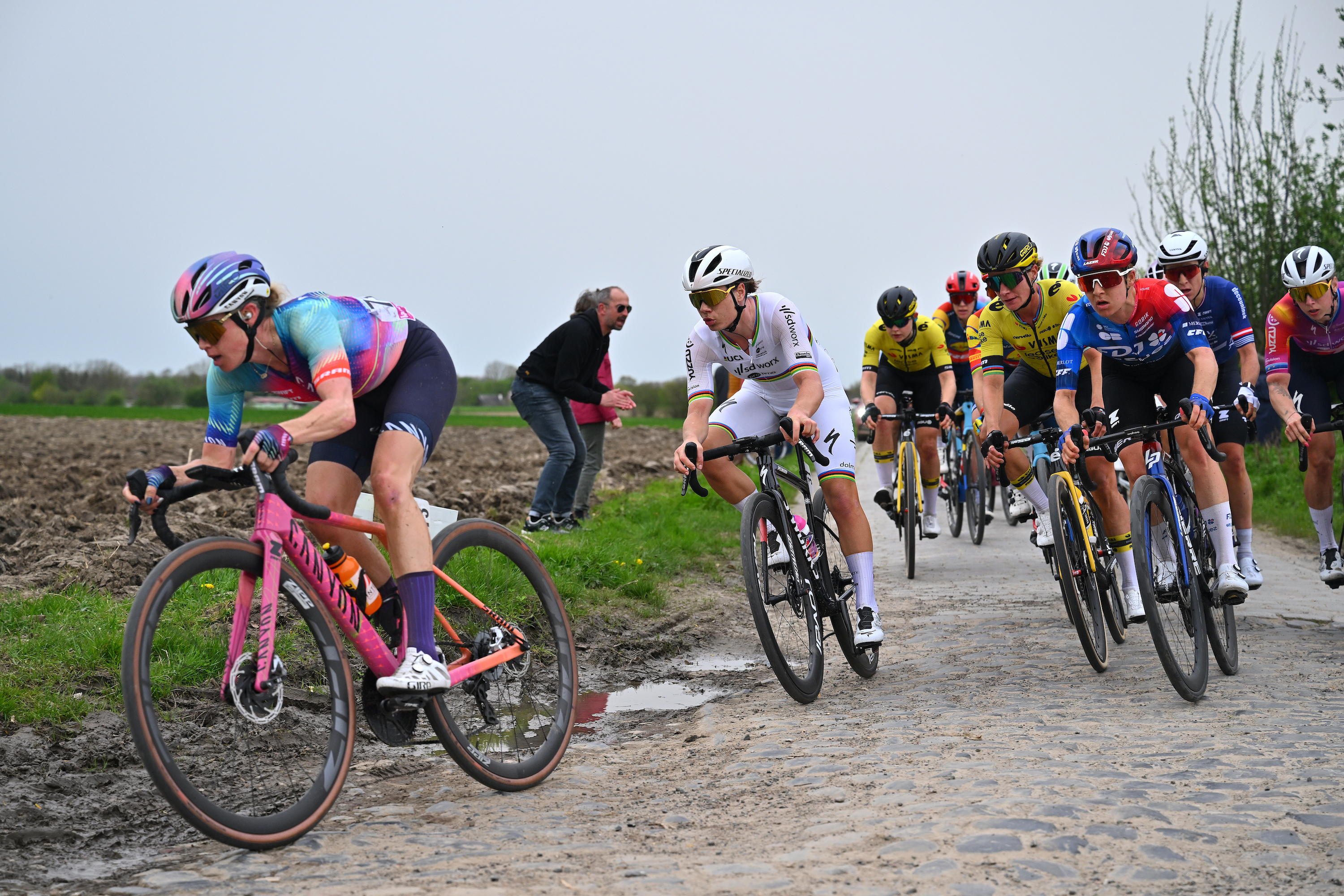 How to watch Paris-Roubaix and Paris-Roubaix Femmes 2025: Everything you need to live stream the Hell of the North
How to watch Paris-Roubaix and Paris-Roubaix Femmes 2025: Everything you need to live stream the Hell of the NorthAll the broadcast information for cycling's brutal cobblestone Classics this weekend – here's how to watch Paris-Roubaix Femmes and Paris-Roubaix from anywhere.
By Adam Becket Published